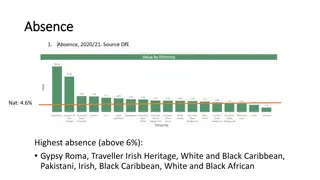
Ancient Black Pottery Traditions From Around the World
Explore the rich history of black pottery, a traditional production method where pots are turned black by stopping combustion at the end of the firing period. This technique has been practiced in various regions worldwide, producing stunning black pottery samples. Discover the methods, examples, and significance of black pottery throughout history.
Download Presentation

Please find below an Image/Link to download the presentation.
The content on the website is provided AS IS for your information and personal use only. It may not be sold, licensed, or shared on other websites without obtaining consent from the author. If you encounter any issues during the download, it is possible that the publisher has removed the file from their server.
You are allowed to download the files provided on this website for personal or commercial use, subject to the condition that they are used lawfully. All files are the property of their respective owners.
The content on the website is provided AS IS for your information and personal use only. It may not be sold, licensed, or shared on other websites without obtaining consent from the author.
E N D
Presentation Transcript
This is one of the most common production way of tradition pottery, where the pots are turned black by stopping combustion at the end of firing period. This could be different ways, for example, by smothering the fire with fine dunk, damp grass or branches of trees, sticks of pine trees etc and then covering all of apertures of kiln. Sometimes the pots are taken out of the fine and plunged into grass, sawdust, dunk and straw. Black pottery sample have been formed in many places in Africa, in Asia, in Europe, in North and South America produced from prehistoric time. Types of Black pottery: There are two main black pottery methods : Bonfire in 500-600 degree Celsius carbonization- firing into the pores of the clay body.
Reduction after firing above 800 degree Celsius and modification of red iron oxide to black iron oxide. Some examples: Early Bronze Age,Il p nar Iznik Museum, Western Turkiye
Prehistoric figurine, Pendik, Istanbul
Early Bronze- Age, Yortan,Western Turkiye
Early Bronze Age, Antalya Museum
Nubian Incised Black Pottery Kerma, Egypt, 2050-1850 B.C.
The vessel from Skarpsalling. 3200 BC. National Museum of Denmark
Prehistoric earthenware vessel decorated with incised geometric motifs filled with white paste. Early Bronze Age, Central Spain.
El Badara Egypt, 4000-3500 B.C. Jar, Predynastic Period, Naqada II3600-3200 B.C.
Etrsk buchero krater, 630-600 B.C., British Museum,
Uttar pradesh ShireAzamgarh /Nizamabad
Philippe Buraud Tjok Dessauvage
A craft, a history in India: We have been hearing from our elders that once a kaji sahib (judge) in the Mughal administration saw black pottery by the Prajapati community in Gujarat. He was so impressed by the work that he brought some artisans to Uttar Pradesh, gave them land for housing and agriculture and asked them to continue the craft, he recollects. Centuries later, the descendants of those craftspeople, about 250 families, continue to make black pottery vases, tea pots, jars, utensils and decorative items for the domestic as well as overseas markets.
While black pottery is also practiced in some other places, he points out why Nizamabad is different. Manipur s black pottery is without the silver patterns while Khurja pottery is glazed. Alwar in Rajasthan is well known for its sheer body pottery (kagzi) but the sandy soil is not suitable for Nizamabad-like black pottery. Manipur sblack pottery
How is black pottery made: In Nizamabad, potters dig out clay from ponds during the dry months of April and May and store it inside their houses for use throughout the year. Their units have small pits into which the clay is filtered, mixed with water and left for some days. When it thickens, the clay is kneaded by feet or using machines to make it lump-free. It is then put on a potter s wheel and shaped into utensils. Prajapati points out that the pottery is partially dried in the sun to retain some moisture. It goes back on the wheel for kharat or peeling off uneven surfaces. This also adds glaze. Kavis, a colour made using clay and water, is applied and the pottery is then left to dry. Mustard oil is then rubbed on it to make it shinier.
A fine iron needle is then used to draw intricate geometrical and floral patterns on the pottery. Women usually do this fine work though men also are experts in the art. The pottery then goes inside the bhatti (oven), which is then fully covered with cow dung cakes. When the pottery is inside the oven, it is important to ensure that there is no scope for oxygen to enter and the heat level remains high. The presence of oxygen can turn the pottery red and it won t get the black colour, which is the hallmark of Azamgarh, Surendra explains.
The oven cools down after 10 to 12 hours and then pottery is removed. A powdered mix of lead, mercury and zinc in equal proportion is now filled into the carved design, giving it a silver finish. Water is then applied, rubbed and applied again to ensure that the silvery powder sticks permanently on the carved design, he adds.
References: Book: Ceramics (A beginner's guide to tool and techniques), Google and Own thinking Thanks . Madan Singh www.madanceramics.com






















